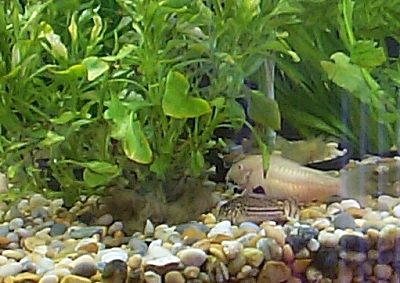|
|
|
 |
| Scientific name | Corydoras aeneus & Corydoras trilineatus |
| Common name | Albino Cory & Three-striped Cory |
| Natural Habitat | South America - Venezuela |
| Appearance |
Both these delightful little fishes share the typical Corydoras shape - arched back and downturned mouth with barbels, and a pronounced dorsal fin. The Albino is an unpigmented version of the Bronze Catfish and has red eyes, like all true albinos, and the striped has an all-over pattern of black dots, scattered all over its back and head and arranged in three lines along its flanks. |
| Maximum size | 3 inches |
| Aquarium Compatibility | Peaceful. The various Corydoras species are all welcome additions to any community aquarium and add movement with their constant scurrying around the tank bottom. |
| Diet | All Corydoras catfish are omnivorous scavenging bottom feeders, but do not expect them to live and thrive on just the scraps the other fish let fall : they deserve feeding too, and will relish a variety of catfish pellets and tablets and especially live bloodworm (make sure you get it from a reliable source to avoid contamination.) |
| Notes |
Corydoras are amongst my favourite fish. They are peaceful, hardy, relatively long-lived and seem to have more "character" than most other fish - I swear mine sit on the bottom, nose to the glass, watching US as we watch THEM. In addition, the Albinos spawn freely in the community tank, although they then abandon their eggs and the rest of the fish relish the eggs as an additional snack. The Corydoras trilineatus I have are juveniles, both under an inch in length, and were sold to me as C. reticulatus, which they clearly are not - a fact I was well aware of when I bought them, as I have kept various species of Corydoras over the years. Whatever the particular species of your Corydoras, they require the same general care, feeding etc. |
Home Page ~ Index of Fishes ~ Aquarium set-up ~ Maintenance ~ Links
|
|
(Left) Albino Corydoras aeneus and (right) Corydoras trilineatus